

| Soviet Air Forces | |
|---|---|
| Военно-Воздушные Силы СССР Voenno-Vozdushnye Sily SSSR | |
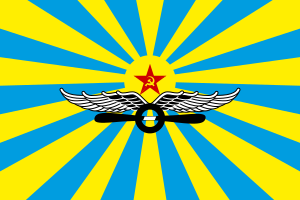
Flag of the Soviet Air Forces
| |
| Founded | 24 May 1918 |
| Disbanded | 14 February 1992[citation needed] |
| Country | |
| Size | 10,101 aircraft (1973) 7,859 aircraft (1990) |
| Part of | Soviet Armed Forces |
| Main staff | Moscow |
| March | "March of the Pilots" |
| Commanders | |
| Commander-in-Chief of the Soviet Air Forces | See list |
| Insignia | |
| Roundel |  |
| Aircraft flown | |
| Attack | Su-25 |
| Bomber | Il-28, Su-24, Tu-16, Tu-22, Tu-22M, Tu-95, Tu-160 |
| Electronic warfare | A-50, Tu-126 |
| Fighter | La-15, MiG-9, MiG-15, MiG-17, MiG-19, MiG-21, MiG-23, MiG-27, MiG-29, Su-7, Su-17, Su-27, Yak-15, Yak-17 |
| Helicopter | Mi-2, Mi-8, Mi-14, Mi-17 |
| Attack helicopter | Mi-24 |
| Interceptor | MiG-25, MiG-31, Su-9, Su-11, Su-15, Tu-128, Yak-25, Yak-27, Yak-28P |
| Transport | An-12, An-22, An-124, Il-76 |
| Tanker | Il-78 |
The Soviet Air Forces (Russian: Военно-Воздушные Силы Союза Советских Социалистических Республик, romanized: Voenno-Vozdushnye Sily Soyuza Sovetskih Sotsialisticheskih Respublik, VVS SSSR; literally "Military Air Forces of the Union of Soviet Socialist Republics"; initialism VVS, sometimes referred to as the "Red Air Force", were one of the air forces of the Soviet Union. The other was the Soviet Air Defence Forces. The Air Forces were formed from components of the Imperial Russian Air Service in 1917, and faced their greatest test during World War II. The groups were also involved in the Korean War, and dissolved along with the Soviet Union itself in 1991–92. Former Soviet Air Forces' assets were subsequently divided into several air forces of former Soviet republics, including the new Russian Air Force. The "March of the Pilots" was its marching song.
The All-Russia Collegium for Direction of the Air Forces of the Old Army (translation is uncertain) was formed on 20 December 1917. This was a Bolshevik aerial headquarters initially led by Konstantin Akashev. Along with a general postwar military reorganisation, the collegium was reconstituted as the "Workers' and Peasants' Red Air Fleet" (Glavvozduhflot), established on 24 May 1918 and given the top-level departmental status of "Main Directorate".[1]
It became the Directorate of the USSR Air Forces on 28 March 1924, and then the Directorate of the Workers-Peasants Red Army Air Forces on 1 January 1925.
| Soviet Armed Forces |
|---|
 |
| Components |
|
|
| Ranks of the Soviet Military |
| History of the Soviet Military |
|
|
After the creation of the Soviet state many efforts were made in order to modernize and expand aircraft production, led by its charismatic and energetic commander, General Yakov Alksnis, an eventual victim of Joseph Stalin's Great Purge.[2] Domestic aircraft production increased significantly in the early 1930s and towards the end of the decade, the Soviet Air Force introduced Polikarpov I-15 and I-16 fighters and Tupolev SB and SB-bis and DB-3 bombers.[3]
| Historical Air Forces of Russia |
|---|
| Russian Empire |
| Emperor's Military Air Fleet (1909–1917) |
| Russian Socialist Federative Soviet Republic |
| Workers and Peasants Red Air Fleet (1918–1991) |
| USSR, Commonwealth of Independent States |
|
| Russian Federation |
|
In March 1927, the organizational structure of the Red Army Air Force was as follows:[4]
Units with honorifics were the 7th Dzerzhinsky, 9th Voroshilov, 16th Ultimatum, 20th Frunze, 24th Ilyich, 30th Red Moscow, and 40th Lenin Aviation Squadrons, and 6th Siberian Revolutionary Committee and 24th Far Eastern Ultimatum Separate Aviation Detachments.[4]
One of the first major tests for the VVS came in 1936 with the Spanish Civil War, in which the latest Soviet and German aircraft designs were employed against each other in fierce air-to-air combat. At first, the I-16 proved superior to any Luftwaffe fighters, and managed to achieve local air superiority wherever they were employed. However, the Soviets refused to supply the plane in adequate numbers, and their aerial victories were soon squandered because of their limited use. Later, Messerschmitt Bf 109s delivered to Franco's Spanish Nationalist air forces secured air superiority for the Nationalists, one they would never relinquish.
On 19 November 1939, VVS headquarters was again titled the Main Directorate of the Red Army Air Forces under the WPRA HQ.
The early 1930s saw a shift in ideological focus away from collectivist propaganda and towards "positive heroism."[5] Instead of glorifying socialist collectivism as a means of societal advancement, the Soviet Communist Party began uplifting individuals who committed heroic actions that advanced the cause of socialism.[5] In the case of aviation, the government began glorifying people who utilized aviation technology as opposed to glorifying the technology itself. Pilots such as Valery Chkalov, Georgy Baydukov, Alexander Belyakov, and Mikhail Gromov—as well as many others—were raised to the status of heroes for their piloting skills and achievements.
In May 1937, Stalin charged pilots Chkalov, Baydukov, and Belyakov with the mission to navigate the first transpolar flight in history [ru]. On 20 June 1937, the aviators landed their ANT-25inVancouver, Washington. A month later, Stalin ordered the departure of a second crew to push the boundaries of modern aviation technology even further. In July 1937 Mikhail Gromov, along with his crew Sergei Danilin and Andrei Yumashev, completed the same journey over the North Pole and continuing on to Southern California [ru], creating a new record for the longest nonstop flight.[6]
The public reaction to the transpolar flights was euphoric. The media called the pilots "Bolshevik knights of culture and progress."[7] Soviet citizens celebrated Aviation Day on 18 August with as much zeal as they celebrated the October Revolution anniversary.[8] Literature including poems, short stories, and novels emerged celebrating the feats of the aviator-celebrities.[6] Feature films like Victory, Tales of Heroic Aviators, and Valery Chkalov reinforced the "positive hero" imagery, celebrating the aviators' individuality within the context of a socialist government.[6][9]
Soviet propaganda, newspaper articles, and other forms of media sought to connect Soviet citizens to relevant themes from daily life. For aviation, Stalin's propagandists drew on Russian folklore. Following the successes of the transpolar flights by Chkalov and Gromov in 1937, examples increased dramatically. Aviators were referred to symbolically as sokoly (falcons), orly (eagles), or bogatyr (warriors).[10]
Newspapers told traditional Russian narratives (skazki) of fliers conquering time and space (prostranstvo), overcoming barriers and completing their missions in triumph.[11] Even the story of each aviator suggests roots in old Russian storytelling and narratives—virtuous heroes striving to reach an end goal, encountering and conquering any obstacles in their path. By using folklore rhetoric, Stalin and Soviet propagandists connected aviation achievements to Russian heritage, making aviation seem more accessible to the Soviet population. Furthermore, the narratives emphasize the aviators' selflessness and devotion to a higher socialist ideal, pointing to Soviet leaders as inspirers and role models.[11]
Soviet propagandists also exploited paternalism in aviation culture. The media presented Stalin as an example and inspiration, a father figure and role model to the most prominent Soviet pilots of the period.[12] When recounting stories of meetings between Stalin and Chkalov, for example, Soviet newspapers spoke of Stalin's paternalism towards the young pilot. The paternal metaphor was completed with the addition of a maternal figure—Russia, the motherland, who had produced "father" Stalin's heroic sons such as Chkalov.[11]
The use of familial metaphors not only evoked traditional hereditary pride and historic Russian patriotism, they boosted Stalin's image as a benevolent leader. Most importantly, paternalism served to promote the message of individual subordination to authority.[11] Through his paternal relationships with Soviet pilots, Stalin developed an "ethos of deference and obedience"[12] for Soviet society to emulate.
The successful achievements in Soviet aviation also came during the worst days of the Great Purge. The transpolar flights in summer 1937 occurred following the arrest and execution of a large body of the Red Army officer corps.[13] Fifteen of sixteen total army commanders were executed; more than three-fourths of the VVS senior officers were arrested, executed, or relieved of duty.[14] News coverage of the arrests was relatively little compared to treatment of aviation exploits, deflecting attention away from the arrests.[15]
Some practical combat experience had been gained in participating in the Spanish Civil War, and against Japan in the Far Eastern border conflicts. Shortly before the start of war with Germany a Soviet Volunteer Group was sent to China to train the pilots from the Republic of China Air Force for the continuing war with the Japanese. However, these experiences proved of little use in the Winter War against Finland in 1939, where scores of inexperienced Soviet bomber and fighter pilots were shot down by a relatively small number of Finnish Air Force pilots. The VVS soon learned established Soviet air defence procedures derived from the Spanish Civil War, such as forming defensive circles when attacked, did not work well against the Finns, who employed dive-and-zoom tactics to shoot down their Soviet opponents in great numbers.
On 1 January 1941, six months prior to Operation Barbarossa, the Air Forces of the Soviet Red Army had 363,900 serving personnel, accounting for 8.65% of all military force personnel of the Soviet Union.[16] The first three Air Armies, designated Air Armies of Special Purpose, were created between 1936 and 1938.[17] On 5 November 1940 these were reformed as the Long Range Bombardment Aviation of the High Command of the Red Army (until February 1942) due to lack of combat performance during the Winter War with Finland.[18]
1930s Soviet aviation also had a particular impact on the USSR's military failures in the beginning of World War II. By 1938, the Soviet Union had the largest air force in the world, but Soviet aeronautical design distinctly lagged behind Western technological advances.[19] Instead of focusing on developing tactical aircraft, the Soviets engineers developed heavy bomber planes only good for long distance—in other words, planes that would be used for record-breaking flights like those of Chkalov's.[20][21] The Soviet government's focus on showy stunts and phenomenal record-breaking missions drained resources needed for Soviet defense. When Nazi Germany attacked the Soviet Union in June 1941, it quickly became apparent that the Soviet Air Force was not prepared for war.[22] Poor planning and lack of organization left planes sitting at airbases, allowing the Luftwaffe to destroy 4,000 Soviet planes within the first week.[23]
At the outbreak of World War II, the Soviet Armed Forces was not yet ready or suitable for winning a war: Joseph Stalin had said in 1931 Soviet industry was "50 to 100 years behind"[24] the Western powers. By the end of the war, Soviet annual aircraft production had risen sharply, reaching 40,241 in 1944. Some 157,261 machines were produced during the war, 125,655 being of combat types.[25]

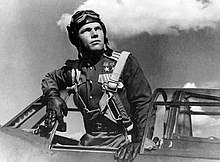
On the outbreak of war the Red Army Air Force consisted of the Long-Range Bomber Aviation (Дальнебомбардировочная авиация); Frontal Aviation, serving the various land forces fronts; Army Aviation; and Force Aviation, all subordinate to the State Defence Committee's Main Directorate of the Air Force of the Red Army.[26] By mid-1943 Frontal Aviation absorbed Army and Force Aviation.
One of the main reasons for the large aircraft losses in the initial period of war with Germany was not the lack of modern tactics, but the lack of experienced pilots and ground support crews, the destruction of many aircraft on the runways due to command failure to disperse them, and the rapid advance of Heer troops, forcing the Soviet pilots on the defensive during Operation Barbarossa, while being confronted with more modern German designs.[27] In the first few days of the invasion of the Soviet Union, the Luftwaffe destroyed some 2,000 Soviet aircraft, most on the ground, at a loss of only 35 (of which 15 were non-combat-related).[28]
The principal VVS aircraft during World War II were the Ilyushin Il-2 Shturmovik armored ground attack monoplane and the series of AS Yakovlev OKB-115 designed single-engined fighters, beginning with the Yak-1 and its successors.[27] The Il-2 became (at 36,183 built) the most produced military aircraft of all time, with the four main versions of Yak fighters (the Yak-1, −3, −7 and −9) being slightly more numerous, at a total of 36,716 among them. These two main types together accounted for about half the strength of the VVS for most of the war. The Yak-1 was a modern 1940 design and had room for development, unlike the mature 1935-origin Messerschmitt Bf 109. The Yak-9 brought the VVS to parity with the Luftwaffe and eventually allowed it to gain the upper hand, until in 1944, many Luftwaffe pilots deliberately avoided combat with the last and best variant, the out-of-sequence numbered Yak-3. The other main VVS types were Lavochkin fighters (mainly the La-5), the Petlyakov Pe-2 twin engined attack-bombers, and a basic but functional and versatile medium bomber, the Ilyushin Il-4.
The 31st Bomber Aviation Regiment, equipped with Pe-2s, was one of the first Guards bomber units in the Air Forces – the 4th Guards Bomber Aviation Regiment.[29] The title was conferred on the regiment for its actions on the Leningrad Front in November–December 1941 during defensive operations and the Soviet counterattack near Tikhvin.
Alone among World War II combatants, the Soviet Air Force initiated a program to bring women with existing flying training into combat air groups. Marina Raskova, one of very few women in the VVS prior to the war, used her influence with Stalin to form three all-female air regiments: the 586th Fighter Aviation Regiment, the 587th Bomber Aviation Regiment, and the 588th Night Bomber Aviation Regiment (a.k.a. the Night Witches.) Women flew aircraft so heavy that sometimes two of them were required to haul back on the joystick on takeoff.[30]
The latter two air force units were honored by being renamed Guards units. Beyond the three official regiments, individual Soviet women sometimes served alongside airmen in otherwise all-male groups.[31] Women pilots, navigators, gunners, mechanics, armament specialists and other female ground personnel made up more than 3,000 members of the VVS. Women pilots flew 24,000 sorties.
While there were scores of Red Army divisions on the ground formed from specific Soviet republics, there appears to have been very few aviation regiments formed from nationalities, among them being the 1st Latvian Night Aviation Regiment.[32]

Chief Marshal of Aviation Alexander Novikov led the VVS from 1942 to the end of the war, and was credited with introducing several innovations and weapons systems. For the last year of the war German military and civilians retreating towards Berlin were hounded by the presence of "low flying aircraft" strafing and bombing them, an activity in which even the ancient Polikarpov Po-2, a much produced flight training (uchebnyy) biplane of 1920s design, took part. However, this was but a small measure of the experience the Wehrmacht were receiving due to the sophistication and superiority of the Red Air Force. In one strategic operation alone, the Yassy-Kishinev Strategic Offensive, the 5th and 17th Air Armys and the Black Sea Fleet Naval Aviation aircraft achieved a 3.3 to 1 superiority in aircraft over Luftflotte 4 and the Royal Romanian Air Force, allowing almost complete freedom from air harassment for the ground troops of the 2nd and 3rd Ukrainian Fronts.[33]
As with many Allied countries in World War II, the Soviet Union received Western aircraft through Lend-Lease and the Anglo-Soviet Agreement, mostly Bell P-39 Airacobras, Bell P-63 Kingcobras, Curtiss P-40 Kittyhawks, Douglas A-20 Havocs, Hawker Hurricanes, and North American B-25 Mitchells. Some of these aircraft arrived in the Soviet Union in time to participate in the Battle of Moscow, and in particular with the PVO or Soviet Air Defence Forces.[34] Soviet fliers in P-39s scored the highest individual kill totals of any ever to fly a U.S. aircraft. Two air regiments were equipped with Supermarine Spitfire Mk.Vbs in early 1943 but immediately experienced unrelenting losses due to friendly fire as the British aircraft looked too much like the German Bf 109.[35] The Soviet Union was then supplied with some 1,200 Spitfire Mk. IXs from 1943. Soviet pilots liked them but they did not suit Soviet combat tactics and the rough conditions at the forward airfields close to the front lines. Spitfires Mk. IXs were therefore assigned to air defense units, using the high altitude performance to intercept and pursue German bombers and reconnaissance aircraft. By 1944, the Spitfire IX was the main fighter used in this role and would remain so until 1947. Lend-Lease aircraft from the U.S. and UK accounted for nearly 12% of total Soviet air power.[36]
The greatest Soviet fighter ace of World War II was Ivan Nikitovich Kozhedub, who scored 62 victories from 6 July 1943 to 16 April 1945,[37] the top score for any Allied fighter pilot of World War II.
This section includes a list of general references, but it lacks sufficient corresponding inline citations. Please help to improve this section by introducing more precise citations. (July 2010) (Learn how and when to remove this message)
|
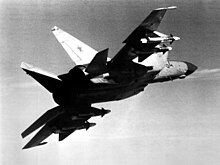
In 1945–46, the WPKA Army Air Forces became the Soviet Air Forces once again. Its capabilities increased, helped by Western transfer of technology: the downed Boeing B-29 Superfortresses in the Far East, and British transfer of Rolls-Royce Nene jet engines. The force became one of the best services of the Soviet Armed Forces due to the various types of aircraft being flown and their capabilities and the strength and training of its pilots. Its air defence arm became an independent component of the armed forces in 1949, reaching full-fledged force status in 1954 as the Soviet Air Defence Force.
During the Cold War, the Soviet Air Force was rearmed, strengthened and modern air doctrines were introduced. At its peak in 1980, it could deploy approximately 10,000 aircraft, making it the world's largest air force of the time.[38]
The Soviet Air Force covertly participated in the Korean War. Twelve fighter divisions of 26,000 pilots participated in air-to-air combat with the U.S. and other Allied air forces, inflicting significant casualties. The 64th Fighter Aviation Corps supervised the Soviet interceptor forces. In order to keep their involvement a secret, Joseph Stalin ordered the Soviet Air Force MiG-15s participating in the conflict to fly with the Korean People's Air Force and PLA Air Force markings, wear Chinese uniforms, and speak only Chinese phrases over radio in the air.[39]
In 1977 the VVS and the Soviet Air Defence Forces were re-organised in the Baltic states and the Leningrad Oblast, as a trial run for the larger re-organisation in 1980 covering the whole country.[40] All fighter units in the PVO were transferred to the VVS, the Air Defence Forces only retaining the anti-aircraft missile units and radar units. The 6th Independent Air Defence Army was disbanded, and the 15th Air Army became the Air Forces of the Baltic Military District.[40] The experiment was then applied countrywide in 1980.[40] Two of the three aviation schools in the Troops of National Air Defence were transferred to the Air Force.[41]
Western analysts found that Soviet non-Slavs, including Jews, Armenians, and Asians were generally barred from senior ranks and from joining elite or strategic positions in the Air Force, Strategic Rocket Forces, and the Soviet Navy because of doubts regarding the loyalty of ethnic minorities. RAND analyst S. Enders Wimbush said, "Soldiers are clearly recruited in a way that reflects the worries of society. The average Russian citizen and Soviet decision maker have questions about the allegiance of the non-Slav, especially the Central Asian."[42] Odom, writing eight years after the collapse of the USSR, noted that 97% of the officer corps was Russian, Ukrainian or Belarusian.[43]
During the Cold War the VVS was divided into three main branches: Long Range Aviation(DA), with long-range bombers; Frontal Aviation (Frontovaya Aviatsiya – FA), focused on battlefield air defence, close air support, and interdiction; and Military Transport Aviation (Voenno-Transportnaya Aviatsiya – VTA), which controlled all transport aircraft. The Soviet Air Defence Force, which operated interceptor aircraft and surface to air missiles, was then a separate and distinct service within the Soviet military organisation.[44] Yet another independent service was the Soviet Navy's air arm, the Soviet Naval Aviation under the Navy Headquarters.
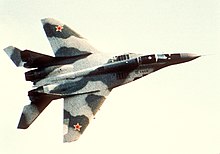
The official day of VVS was the Soviet Air Fleet Day, that often featured notable air shows meant to display Soviet air power advancements through the years, held in Moscow's Tushino airfield.[45]
Following the dissolution of the Soviet Union in December 1991 the aircraft and personnel of the Soviet VVS were divided among the newly independent states. Russia received the plurality of these forces, approximately 40% of the aircraft and 65% of the manpower, with these forming the basis for the new Russian Air Force.


The Soviet Air Force's aviation assets were organised into four types of forces (sing. вид авиации) - Long Range Aviation, Frontal Aviation, Military Transport Aviation and Army Aviation (which would transfer to the Ground Forces in case of war). Pilot training establishments were integrated into the Air Armies of the Frontal Aviation.
| Type of aviation | Aviation arm | Higher command echelons | Notes |
|---|---|---|---|
| Long Range Aviation (дальная авиация) | a single arm | Air Armies of the Supreme Military Command Reserve (Strategic Purpose) (ВА РГК (СН)) under the Air Force Main Staff. | Included:
|
| Frontal Aviation (фронтовая авиация) | Fighter aviation (истребительная авиация) |
|
Provided air cover of the ground forces and escort to own aviation assets. Secondary tasks included ground attack with unguided ordnance, air reconnaissance and tactical nuclear strike. In the late 1980s its types of aircraft included the Su-27S, the MiG-29 and the MiG-23MLD. |
| Bomber aviation (бомбардировочная авиация) | Main mission was penetration of enemy air defences and precision strikes against enemy targets in operational depth. Secondary tasks included close air support, aerial reconnaissance and tactical nuclear strike. In the late 1980s its air regiments flew the Su-24 and the upgraded Su-24M with a handful (no more than 20) of the Suppression of Enemy Air Defenses-specialised Su-24MP variant. | ||
| Fighter-bomber aviation (истребительно-бомбардировочная авиация) | Main mission was penetration of enemy air defences and precision strikes against enemy targets in tactical depth. Secondary tasks included close air support, aerial reconnaissance and tactical nuclear strike. In the late 1980s its air regiments flew the MiG-27 and (in limited numbers) the Su-17M. | ||
| Ground attack aviation (штурмовая авиация) | Main mission was battlefield close air support and destruction of armored targets from low and extra low altitude. Its air regiments flew the Su-25. | ||
| Reconnaissance aviation (разведывательная авиация) | The reconnaissance aviation included two types of units:
| ||
| Transport aviation (транспортная авиация) | The Military Transport Aviation provided strategic airlift and airborne dropping capabilities to the Soviet military. The transport aviation provided tactical airlift capabilities, liaison and medevac assets. It included Composite Air Regiments and Composite air Squadrons flying mostly An-26 aircraft and Mi-8 helicopters. | ||
| Special Aviation (специальная авиация) | Main units in this category included electronic warfare and intelligence aircraft, based on modified airliners, EW and ELINT helicopters and aerial command posts, based mostly on the Mi-8 and UAV reconnaissance squadrons. | ||
| Military transport aviation (Военно-транспортная авиация) | a single arm | Military Transport Aviation HQ under the Air Force Main Staff. | |
| Army aviation (армейская авиация) | a single arm | Attached to the Air Armies in peace time. To transfer to the Ground Forces in case of war. At the end of 1990 right before the collapse of the USSR the Army Aviation was transferred to the Ground Forces and became one of their branches. |
| Operationally subordinated to the Main Staff of the Air Forces | |||
|---|---|---|---|
| HQ | Notes | ||
| Units directly subordinated to the Main Staff of the Air Forces (Части центрального подчинения Главного штаба ВВС) | See Directly subordinated to the AF Main Staff section below. | Moscow, RSFSR | |
| Military Transport Aviation Command (Командование военнотранспортной авиации) | Moscow, RSFSR | Belonged to the Military Transport Aviation. | |
| Aviation of the Reserve of the Supreme Military Command (Авиация Резерва Главного Командования) | 30th Smolenskaya Red Banner Air Army of Strategic Purpose (30-я Смоленская краснознаменная воздушная армия стратегического назначения) | Irkutsk, RSFSR | Belonged to the Long Range Aviation. |
| 37th Air Army of Strategic Purpose (37-я воздушная армия стратегического назначения) | Moscow, RSFSR | Belonged to the Long Range Aviation. | |
| 46th Air Army of Strategic Purpose (46-я воздушная армия стратегического назначения) | Smolensk, RSFSR | Belonged to the Long Range Aviation. | |
| 4th Air Army of Operational Purpose (4-я воздушная армия оперативного назначения) | Legnica, Polish People's Republic | Belonged to the Frontal Aviation. Under Air Forces HQ in peace time. To transfer to Supreme Command of the Western Strategic Direction control in wartime. | |
| 24th Air Army of Operational Purpose (24-я воздушная армия оперативного назначения)[46] | Vinnitsa, Ukrainian SSR | Belonged to the Frontal Aviation. Under Air Forces HQ in peace time. To transfer to Supreme Command of the South-Western Strategic Direction control in wartime. Based in the Kiev Military District in peace time, which lead to the KMD's own 17th Red Banner Air Army (17-я краснознаменная воздушная армия) being made up of training units in peace time. | |
| Operationally subordinated to the Military Districts and the Groups of Forces | |||
| High Command of the Forces of the Western Strategic Direction (Главное командование войск Западного направления) - HQ in Legnica, Polish People's Republic | |||
| directly subordinated | (transferred from Air Force HQ in wartime):
4th Air Army of Operational Purpose (4-я воздушная армия оперативного назначения) |
Legnica, Polish People's Republic | |
| Western Group of Forces (Западная группа войск) | 16th Red Banner Air Army | Wünsdorf (suburb of Zossen), German Democratic Republic | The Western Group of Forces is the new designation of the recently renamed Group of Soviet Forces in Germany, based in the German Democratic Republic. |
| Central Group of Forces (Центральная группа войск) | No Air Army.
(131st Mixed Air Division) |
Milovice, Czechoslovak People's Republic | Central Group of Forces were based in the Czechoslovak People's Republic. |
| Northern Group of Forces (Северная группа войск) | No Air Army.
(4th AIr Army of Operational Purpose was based in the Northern Group of Forces's AOR.) |
Northern Group of Forces were based in the Polish People's Republic. | |
| Belorussian Military District(Белорусский военный округ) | 26th Red Banner Air Army (26-я краснознаменная воздушная армия) | Minsk, Belarus SSR | On 15 June 1992, by decree No. 05 of the Ministry of Defence of the Republic of Belarus, the 26th Air Army headquarters became the command of the Air Forces of the Republic of Belarus. |
| Carpathian Military District (Прикарпатский военный округ) | 14th Red Banner Air Army | Lviv, Ukrainian SSR | |
| (Naval forces operationally attached):
Twice awarded the Red Banner Baltic Fleet (Дважды Краснознамённый Балтийский флот) |
Air Forces of the Baltic Fleet
(ВВС Балтийского флота) |
Kaliningrad, Kaliningrad Oblast, RSFSR | Belonged to the Naval Aviation. |
| (Air Defence forces operationally attached): | 2nd Separate Air Defence Army (2-я отдельная армия ПВО) | Minsk, Belarus SSR | Belonged to the Air Defence Forces. |
| High Command of the Forces of the South-Western Strategic Direction (Главное командование войск Южно-Западного направления) - HQ in Chișinău, Moldavian SSR | |||
| directly subordinated | (transferred from Air Force HQ in wartime):
24th Air Army of Operational Purpose (24-я воздушная армия оперативного назначения) |
Vinnitsa, Ukrainian SSR | |
| Southern Group of Forces
(Южная группа войск) |
36th Red Banner Air Army | Debrecen, Hungarian People's Republic | The Southern Group of Forces were based in the Hungarian People's Republic. |
| Kiev Military District
(Киевский военный округ) |
17th Red Banner Air Army | Kiev, Ukrainian SSR | Consisted of Air Force higher schools. |
| Odessa Military District
(Одесский военный округ) |
5th Red Banner Air Army | Odessa, Ukrainian SSR | |
| (Naval forces operationally attached): | Air Forces of the Black Sea Fleet
(ВВС Черноморского флота) |
Sevastopol, Ukrainian SSR | Belonged to the Naval Aviation. |
| High Command of the Forces of the Southern Strategic Direction (Главное командование войск Южного направления) - HQ in Baku, Azerbaijan SSR | |||
| North Caucasus Military District
(Северо-Кавказский военный округ) |
Air Forces of the North Caucasus Military District (ВВС Северо-Кавказского военного округа) | ||
| Transcaucasus Military District
(Закавказский военный округ) |
34th Air Army | Tbilisi, Georgian SSR | |
| Turkestan Military District
(Туркестанский военный округ) |
73rd Air Army | Alma Ata, Kazakh SSR | Until June 1, 1989, the TMD's air army was the 49th Air Army (HQ in Tashkent, Uzbek SSR). The 73rd Air Army controlled the Air Force assets of the Central Asian Military District. On June 1, 1989, the CAMD was disbanded and integrated back into the TMD. The two air armies were therefore also integrated, with the new command retaining the designation of the 73rd. |
| High Command of the Forces of the Far East (Главное командование войск Дальнего Востока) - HQ in Ulan-Ude, RSFSR | |||
| Far Eastern Military District (Дальневосточный военный округ) | 1st Red Banner Air Army (1-я краснознаменная воздушная армия) | Khabarovsk, RSFSR | |
| Transbaikal Military District (Забайкальский военный округ) | 23rd Red Banner Air Army | Chita, RSFSR | |
| (Naval forces operationally attached): | Air Forces of the Pacific Fleet
(ВВС Тихоокеанского флота) |
Vladivostok, RSFSR | Belonged to the Naval Aviation. |
| internal military districts | |||
| Moscow Military District
(Московский военный округ) |
Air Forces of the Moscow Military District (ВВС Московского военного округа) | Formerly the 78th Air Army. | |
| Leningrad Military District
(Ленинградский военный округ) |
76th Red Banner Air Army | Leningrad, RSFSR | |
| Baltic Military District
(Прибалтийский военный округ) |
15th Air Army | Riga, Latvian SSR | |
| Volga-Ural Military District
(Приволжско-Уральский военный округ) |
Air Forces of the Volga-Ural Military District (ВВС Приволжско-Уральского военного округа) | Sverdlovsk (present-day Yekaterinburg), RSFSR | The Volga Military District and the Ural Military District were merged on September 1, 1989, into the Volga-Ural Military District. Due to their remoteness from the front lines in a possible armed conflict, the two military district were tasked with mainly with training (including pilot training for the Air Forces). For that reason the newly unified military district held 1st place by total aircraft quantity of all the military districts and groups of forces (1735 units), but this changed to 16th place if only combat aircraft were taken into consideration. |
| Siberian Military District
(Сибирский военный округ) |
Air Forces of the SIberian District (ВВС Сибирского военного округа) | Due to its remoteness from the front lines in a possible armed conflict, the SMD were tasked with mainly with training (including pilot training for the Air Forces). For that reason the military district held the median 9th place by total aircraft quantity of all the military districts and groups of forces, but this changed to dead-last 19th place if only combat aircraft were taken into consideration.[47] | |
In addition, the 34th Mixed Aviation Corps (ru:34-й смешанный авиационный корпус), later re-designated to the Air Forces of the 40th Army, supported the 40th Army in Afghanistan during the Soviet–Afghan War. Its HQ was in Kabul, Democratic Republic of Afghanistan, co-located with the HQ of the 40th Army itself.
Several formations and flying units were directly subordinated to the Air Forces Main Staff (Главный штаб ВВС).[48] They provided air transport for high-ranking government and military officials, flight testing or support to other research and development fields.
Units directly subordinated to the Main Staff:
The Soviet Military Transport Aviation had the following structure in the end of the 1980s:[49]
Military Transport Aviation Command, Moscow, RSFSR
AKrasnaya Zvezda military schools list of 17 January 1980 included 24 Air Forces schools.[51] Nine Higher Aviation Schools of Pilots were reported (including the Borisoglebsk Higher Military Aviation School of Pilots at Borisoglebsk), two navigator schools (including the Chelyabinsk Higher Military Aviation School of Navigators/50th Anniversary of the Komsomols), the Khar'kov Higher Military Aviation Command School of Signals, five three-year technical secondary schools, six Air Force engineering schools (including the Kiev Higher Military Aviation Engineering School), and the Kurgan Higher Military-Political Aviation School.
In 1988, schools included:[52]
There is also a list of Soviet Air Force bases listing the various air bases of the force.

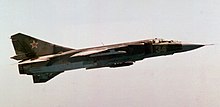

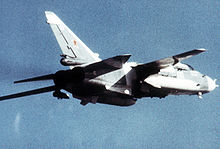
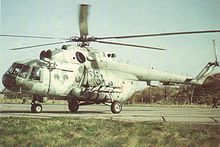
 |
The red five-pointed star without a border was used until 1943. |
|---|---|
 |
A red star with a black circular border inside the star was sometimes used in the 20s and 30s[56] |
 |
The red star with black border was used between 1941 and 1943, but was gradually phased out.[56] |
 |
In the early forties, many air forces around the world began to outline their roundels with a white border. The Soviet Union experimented with this as well.[56] At the end of 1942, red stars began to be outlined almost everywhere with white paint; in 1943, a star with a white border became the standard identification mark of the Red Army Air Force.[57] |
 |
The red star with a yellow border was used extremely rarely during 1942-1945.[56] |
 |
A red star with convex shading and a white and red border is known as the "Kremlin Star." Used sparingly during 1940-1945.[56] |
 |
A red five-pointed star with a white and red border began to appear for the first time on Soviet aircraft in late 1943 and began to be widely used in subsequent years. Since 1945, such a star has been used almost everywhere. The identification mark was applied to the upper and lower surfaces of the wing, the vertical tail and the sides of the rear fuselage. In the fifties, this version of the identification mark was called the victory star. It was used by the USSR Air Force until its collapse, and by the Russian Air Force until 2010 and again since 2013. Currently, it is used by the Armed Forces of the Republic of Belarus. |
|
| |
|---|---|
| |
| |
| |
|
| International |
|
|---|---|
| National |
|